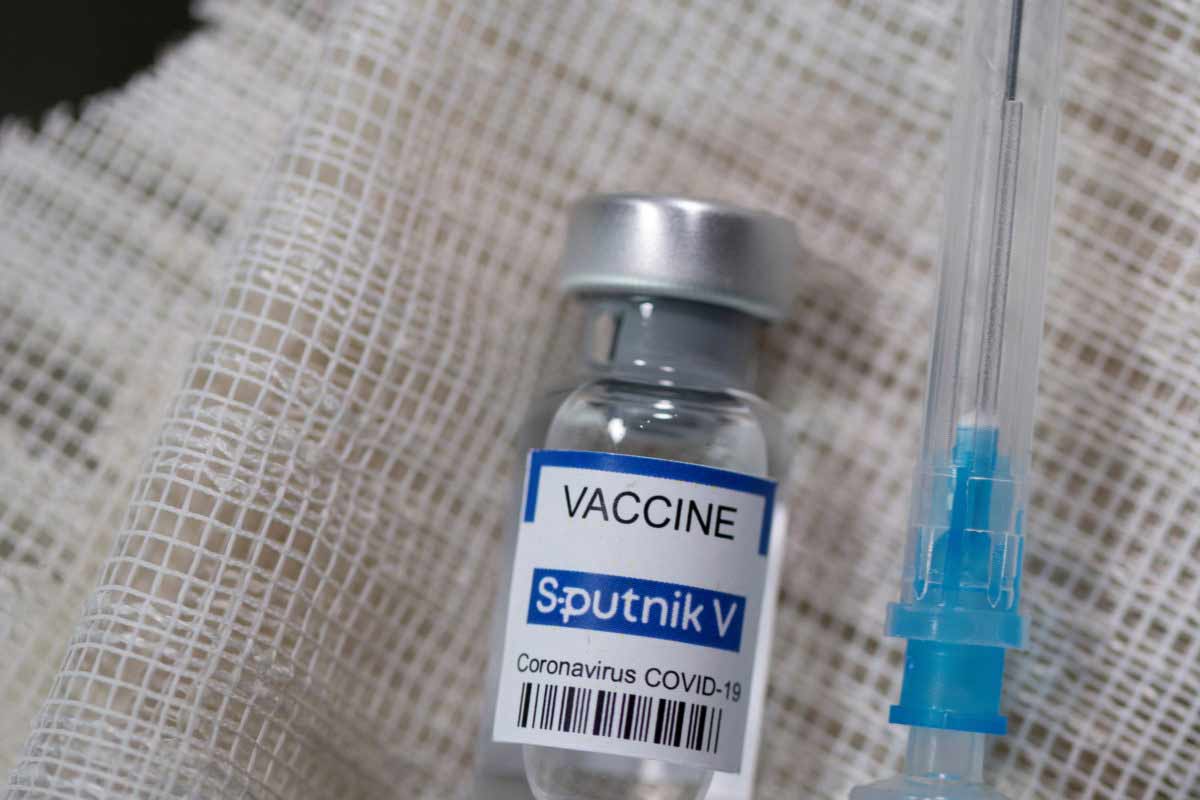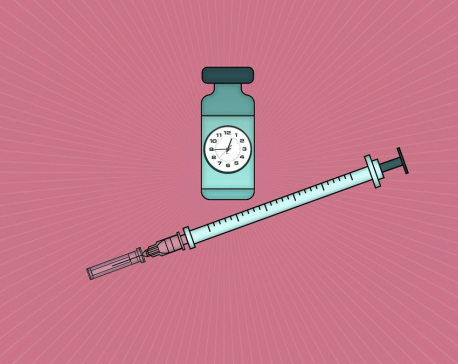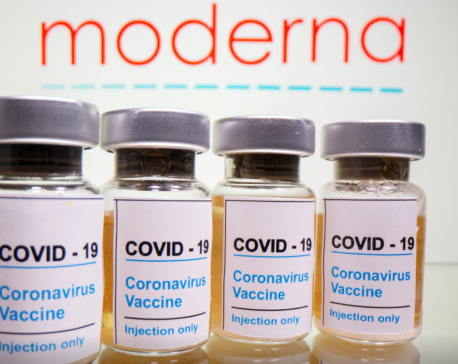
OR
Containing Second wave of Covid Pandemic
It is time Nepali people should say ‘Yes’ to Russian Sputnik Vaccine too
Published On: April 22, 2021 06:55 PM NPT By: Dr Mahesh K Maskey


Dr Mahesh K Maskey
The author, former Ambassador of Nepal to China, is also a former Vice President of International Physicians for Prevention of Nuclear Warnews@myrepublica.com
Nepal is now facing second wave of Covid19 pandemic and by all indications it is spreading at a much faster speed than the earlier wave. This rate of transmission is expressed by how quickly the number of cases double and what is the trend of detection of cases per person tested. For last two weeks Cases are doubling in about seven days, and case test ratio has spiked to about 20% as a national average. Individual places have inordinately faster rate of infection. Nepalganj reported a recent case test ratio as 100% i.e. all the tested people turned out to be positive.
This is happening when only a fraction of Nepali adult population are covered by Indian Covishield and Chinese Sinopharma vaccines and India is in second wave of Covid pandemic with massive surge of cases primarily affected by UK and indigenous variants of Corona virus. All the adjoining border states of India, without exception, are showing huge tides of covid19 cases, an ominous sign for an open border country like Nepal. Nepal Government Ministry of Health and Population had rung the alarm and took initiative to contain the infection at a very early sign of the coming of second wave. However, it seems certain districts are already in neck deep waters in spite of such warnings and control measures.
Four measures are of utmost importance to face this new challenge of Covid19 scare. Preventive personal safety measures such as wearing of masks, physical distancing and hand cleaning with soap water or sanitizer are still the most effective measures. Second is increase in capacity and quality of quarantine, home isolation, institutional isolation and hospital isolation beds including ICU and Ventilators, with ensured supplies of oxygen and medicines.Third is smart and selective lockdown.Fourth is vaccine coverage to all adult population.The trio of “Test, Trace and Treat” is only effectively applicable when these measures are in place.
The first and third are intertwined with each other. The more people lax their vigilance and abandon safety measures the more will the government be forced to call for lockdowns of various kinds. Compared to the first wave now young people are becoming more infected and hence turning into vehicle of transmission. They also appear to be the least in observing safety measures. It is for this reason schools are being closed in high risk areas. But the challenge remains for finding out ways of a ‘new normal’ to make schools safe and students and teacher observe the precautionary measures so that education be carried out amidst these waves of infectious diseases. It is a tragic trade off between education and health. Closing of schools are not permanent solutions.
Because of weakened preventive measures and insufficient level of herd immunity, the virus can still wriggle through the communities and infect the susceptible people. The second measure comprising of quarantine, isolation and hospital beds are of utmost importance to handle this challenge. It is vital for border districts where influx of people across the border increases the risk of transmission. But even more so for Kathmandu Valley where along with such influx almost half of its population being tenants pose special problem for home isolation. Sufficient number of institutional quarantine and isolation centers, the likes of KirtipurAyurvedic Research Center and Kharipati, are urgently needed to be operationalized within a window period of few weeks before the covid surge become unmanageable.
Failure to address this problem was one of the root causes of the massive surge of cases and deaths in Kathmandu valley in the first wave. Learning from the mistakes of past, Kathmandu has to secure a chain of Covid dedicated hospitals to provide care for all who need hospitalization. This can be done by turning a substantial number of private hospitals into Covid hospitals made operational under the guidance of Sukra Raj Tropical hospital. Parsa had set a successful example in making available such Covid beds in sufficient number. But Kathmandu, even though a few small hospital were made covid hospital, turned a deaf ear to such suggestions and forced all the hospitals to provide covid beds. So in paper there were large number of covid beds. But in practice the patients were turned away from one hospital to other costing their lives because of delayed treatment. This time too there is a risk of repeating the same mistake. The daily papers are now full of news repeating exactly same stories as before.
In fact all over Nepal, temporary Covid dedicated hopitals are needed whether governmental or private. The local municipality wards are in the forefront of Covid challenge and should be equipped with home and institutional quarantine and isolation facilities, transportation and access to such Covid hospital beds to provide needed care to Covid positive patients in their wards. As is evident, all these measures make an integrated whole which works with judicious use of selective and smart lockdown. Such measures may help to flatten the curve before it is too late.
All these measures are important but in the absence of required vaccination coverage for attaining a protective herd immunity,it is either not possible or would be very costly in terms of human suffering and loss of life. Sometimes back I was asked which vaccines may be appropriate for Nepal? My answer was Indian, Chinese and Russian. I am confident that the answer was valid then and even more valid at present. We are already getting vaccinated by vaccines produced by India and China. Russian vaccine, on the other hand has just received emergency approval from the government, which I believe, is a wise and considered decision and Nepali people should say ‘yes’ to Sputnik vaccine too.
Sputnik Vaccine adopted a smart approach for enhancing efficacy using two different adenoviruses vectors as ‘postmen’ to deliver Covid spike protein to the human cells. It could be stored and transported in similar cold chains as other two vaccines and was affordably priced. But There were several reasons for delay in the decision. Even though one of the first Covid vaccine of the world to come to the limelight pushed by President Putin himself, its earlier clinical trials were done in very small number of people, hence drawn a substantial reservation about its efficacy and safety in the scientific community. Also for Nepal it had created confusion and controversy by a news that had claimed a contract between Russian Direct Investment Fund (RDIF) and Trinity Pharmaceuticals is supplying 25 million vaccines to Nepal. The Nepal government had reportedly denied such claims as no such application had been received and the Pharmacy in question was found not even registered to Department of Drug Administration Nepal.
But by February, 2021 several important developments made the Russian Vaccine one of the most attractive vaccine for developing countries in fight against Covid Pandemic. The declaration of Oxford AstraZenecato work together with Russian Gamelaya Institute, for developing a new higher efficacious hybrid vaccine by combining both of their vaccines, enhanced its credibility. [It should be recalled here that the vaccine developed by Oxford-AstraZeneca is manufactured by Serum institute of India as “Covishield”]. But more importantly publication in the journal “The Lancet” the interim analysis of carefully designed phase III clinical trial of Sputnik V vaccine by Russian scientists changed the tide in its favor in the critical mass of scientists.
Sputnik V vaccine is a two dose regimen. But at the time of publication in the lancet, efficacy and safety of single dose in the clinical trial was assessed as the data after the second booster dose was not available. A single dose was found to be equally safe and more efficacious (91.6%) compared to the two dose regimen of both Indian (62-82%) and Chinese vaccine (79-84%). It efficacy was similar in all age group above 18 years age which is particularly attractive for people above age group 60 yrs. Serious adverse effects were rare and found to be unrelated to vaccine. These effects were measured on 21 days after the first dose of Sputnik vaccine. This high efficacy of single dose in the interim analysis has prompted the Russian scientists to study the feasibility of a single dose Sputnik vaccine which may be another milestone in Covid vaccine development.
However, the just published “real world” assessment data of 3.8 million people vaccinated with two dose of Sputnik vaccine in Russia found even higher efficacy (97.6%). If this claim is scrutinized and found valid, then Russian vaccine will achieve the highest rank in efficacy among all Covid vaccines developed so far, overtaking Pfizer and Moderna as well.
Nepal has been fortunate to have two neighbors who were vaccine producers hence one of the early countries who is benefited by both Indian(Covishield) and Chinese (Sinopharmverocell) vaccine. However because of the scary second wave within India and demand of the rest of the world, India does not seem to be in position to provide sufficient vaccines to its own populace. Its “vaccine matri” diplomacy has been criticized within its own boundaries for not adequately considering the need of Indian people and providing more vaccine to other countries compared to internal consumption. Two major policy shifts happened in this context: stopping export of India produced vaccine to other countries and grant emergency approval to Russian Sputnik Vaccine to meet the demand of vaccination to its people.
In South Asia, Pakistan and Srilanka have also given emergency approval to Sputnik V vaccine. Bangladesh is considering not only approval but also the production of vaccine with technical support of Russia, eyeing its market in India and other South Asian Countries. Moving further than emergency approval, Nepal should take a bold step in laying the ground work for manufacturing this vaccine in its own country. Russia is an old friend of Nepal and a trilateral cooperation between Nepal, Russia and Bangladesh may provide the ‘turnkey’ of vaccine diplomacy for such dream project.
Mahesh Maskey, Former Ambassador to China and Executive Chief, Nepal Public Health Foundation, maskeymk8@gmail.com
You May Like This

How long does protection from COVID-19 vaccines last?
NEW YORK, May 14: Experts don’t know yet because they’re still studying vaccinated people to see when protection might wear... Read More...

Moderna to charge $25-$37 for COVID-19 vaccine: CEO tells paper
FRANKFURT, Nov 22: Moderna will charge governments between $25 and $37 per dose of its COVID-19 vaccine candidate, depending on... Read More...

Oxford COVID-19 vaccine trials produce robust immune response in elderly
LONDON, Oct 26: Early results from tests for a coronavirus vaccine being developed by the University of Oxford, in collaboration... Read More...











Just In
- Challenges Confronting the New Coalition
- NRB introduces cautiously flexible measures to address ongoing slowdown in various economic sectors
- Forced Covid-19 cremations: is it too late for redemption?
- NRB to provide collateral-free loans to foreign employment seekers
- NEB to publish Grade 12 results next week
- Body handover begins; Relatives remain dissatisfied with insurance, compensation amount
- NC defers its plan to join Koshi govt
- NRB to review microfinance loan interest rate







Leave A Comment